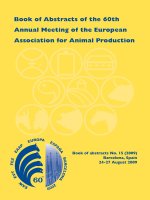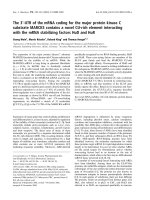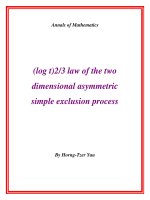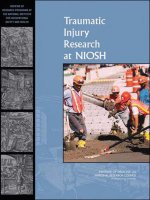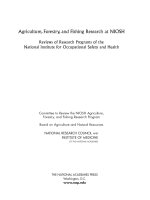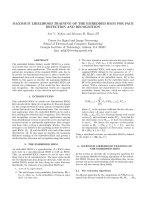Encompassing new use cases - level 3.0 of the HUPO-PSI format for molecular interactions
Bạn đang xem bản rút gọn của tài liệu. Xem và tải ngay bản đầy đủ của tài liệu tại đây (1.21 MB, 8 trang )
Sivade (Dumousseau) et al. BMC Bioinformatics (2018) 19:134
/>
SOFTWARE
Open Access
Encompassing new use cases - level 3.0 of
the HUPO-PSI format for molecular
interactions
M. Sivade (Dumousseau)1, D. Alonso-López2, M. Ammari3, G. Bradley4, N. H. Campbell5, A. Ceol6, G. Cesareni7,
C. Combe8, J. De Las Rivas2, N. del-Toro1, J. Heimbach9,10, H. Hermjakob1,11, I. Jurisica12,13, M. Koch1, L. Licata7,
R. C. Lovering5, D. J. Lynn14,15, B. H. M. Meldal1, G. Micklem9,10, S. Panni16, P. Porras1, S. Ricard-Blum17, B. Roechert18,
L. Salwinski19, A. Shrivastava1, J. Sullivan9,10, N. Thierry-Mieg20, Y. Yehudi9,10, K. Van Roey21 and S. Orchard1*
Abstract
Background: Systems biologists study interaction data to understand the behaviour of whole cell systems, and
their environment, at a molecular level. In order to effectively achieve this goal, it is critical that researchers have
high quality interaction datasets available to them, in a standard data format, and also a suite of tools with which
to analyse such data and form experimentally testable hypotheses from them. The PSI-MI XML standard
interchange format was initially published in 2004, and expanded in 2007 to enable the download and interchange
of molecular interaction data. PSI-XML2.5 was designed to describe experimental data and to date has fulfilled this
basic requirement. However, new use cases have arisen that the format cannot properly accommodate. These
include data abstracted from more than one publication such as allosteric/cooperative interactions and protein
complexes, dynamic interactions and the need to link kinetic and affinity data to specific mutational changes.
Results: The Molecular Interaction workgroup of the HUPO-PSI has extended the existing, well-used XML
interchange format for molecular interaction data to meet new use cases and enable the capture of new data
types, following extensive community consultation. PSI-MI XML3.0 expands the capabilities of the format beyond
simple experimental data, with a concomitant update of the tool suite which serves this format. The format has
been implemented by key data producers such as the International Molecular Exchange (IMEx) Consortium of
protein interaction databases and the Complex Portal.
Conclusions: PSI-MI XML3.0 has been developed by the data producers, data users, tool developers and database
providers who constitute the PSI-MI workgroup. This group now actively supports PSI-MI XML2.5 as the main
interchange format for experimental data, PSI-MI XML3.0 which additionally handles more complex data types, and
the simpler, tab-delimited MITAB2.5, 2.6 and 2.7 for rapid parsing and download.
Keywords: Molecular interactions, Protein-protein interaction, Protein complexes, Data standards, XML, HUPO-PSI, PSI-MI
* Correspondence:
1
European Bioinformatics Institute (EMBL-EBI), European Molecular Biology
Laboratory, Wellcome Genome Campus, Hinxton CB10 1SD, UK
Full list of author information is available at the end of the article
© The Author(s). 2018 Open Access This article is distributed under the terms of the Creative Commons Attribution 4.0
International License ( which permits unrestricted use, distribution, and
reproduction in any medium, provided you give appropriate credit to the original author(s) and the source, provide a link to
the Creative Commons license, and indicate if changes were made. The Creative Commons Public Domain Dedication waiver
( applies to the data made available in this article, unless otherwise stated.
Sivade (Dumousseau) et al. BMC Bioinformatics (2018) 19:134
Background
Understanding the interaction networks that govern
biological systems is essential to fully decipher the molecular mechanisms ensuring cellular biology and tissue
homeostasis. Interactions between molecules result in
both the assembly of stable functional protein complexes,
which form the molecular machinery of the cell, and
transient, often regulatory, networks of weakly associating molecules. Together these drive and regulate
cellular processes, cell-cell interactions and cell-matrix
interactions. The capture and curation of published
interaction data has been the work of interaction databases for many years, and many of these resources
have collaborated through the Molecular Interaction
workgroup of the Human Proteome Organization
Proteomics Standards Initiative (HUPO-PSI) to create
and maintain community data formats and standards
[1]. These formats and standards have enabled the
systematic capture, reuse and exchange of these data
and the building of tools to enable network
contextualization and analysis of -omics data.
Version 1.0 of PSI-MI XML was published in 2004 and
enabled the description of simple protein interaction data
[2]. The format was widely implemented and supported
by both software tool developers and data providers, but
was soon found to be too limited in its scope. To facilitate
rich, integrative analyses, many databases wished to describe and exchange the full wealth of data generated by
interaction experiments, including a detailed description
of experimental conditions and features such as binding
sites or affinity tags on participating molecules. In order
to make this possible, the Molecular Interactions working
group of the HUPO-PSI further extended the XML
schema to enable the annotation of a wider range of data.
PSI-MI XML2.5 expanded the type of interactors to encompass any molecule or complex of molecules which
can be described in the ‘interactor type’ branch of the
accompanying controlled vocabulary (PSI-MI CV) [3].
Sequence or positional features on a participant molecule
that are relevant for the interaction can be described in a
featureList, again using an appropriate controlled vocabulary term. The PSI-MI XML2.5 schema allows two different representations of interactions. The compact format
was designed for larger datasets. In this, the repetitive
elements of a larger set of interactions, such as the interactors and experiments, are only described once, in the
respective list elements, and subsequently referred to. The
extended format groups all related data closely together
and was designed to simplify parsing. This version of the
schema also supports the hierarchical build-up of complexes from component sub-complexes.
Version 2.5 has proven to be, and will continue to be,
capable of capturing the vast majority of molecular
interaction data, generated by techniques such as protein
Page 2 of 8
complementation assays, affinity capture, biophysical
measurements and enzyme assays. It successfully describes genetic as well as physical interactions, and can
also be used to hold predicted interactions or the results
of text-mining exercises, all clearly described as such by
appropriate controlled vocabulary terms. Consequently,
this version of the format will continue to be supported
by the PSI-MI community for the foreseeable future.
However, use cases have arisen which cannot be adequately described within this XML schema, and in 2013
it was decided that the field had advanced sufficiently to
justify moving to the next level in this deliberately tiered
approached to describing interaction data, and to produce PSI-MI XML3.0.
Implementation
A community standard will only remain of use to that
community if it meets the needs of current and future
users, and if these users have bought into, and contributed to, the update process. Prior to creating any
changes in the schema, a questionnaire was sent out to
known users of the format to establish how PSI-MI
XML2.5 was currently being utilised, and to identify
cases in which the format was not meeting user needs.
Once an initial list of requirements had been established,
use cases and examples of each were collated. Initial
proposals or, in some cases, multiple proposals for tackling each case were drawn up and circulated to mailing
lists and known format users. Each proposal, and any
subsequent feedback, was then discussed in detail at the
2014 HUPO-PSI meeting by attendees to the MI work
track [4]. The final list of use cases was agreed upon and
the changes to PSI-MI XML2.5 described below approved and subsequently implemented. Additional file 1
contains an example file showing the representation of
the molecular interaction data from a single publication
in PSI-MI XML3.0.
Enhancements to the description of molecule features
In PSI-MI XML 2.5 the featureList element describes
the sequence features of the participant that are relevant
to the interaction, using the appropriate term or terms
from the corresponding controlled vocabulary, for example ‘sufficient binding region’ (MI:0442) or experimental modifications such as ‘green fluorescent protein
tag’ (MI:0367) linked from the featureType element. The
featureRangeList describes the location of a feature on
the participant sequence. In PSI-MI XML3.0 a series of
changes, listed below, have been implemented to enable
more details to be added to the description of a feature.
a. The position attribute type and interval attribute
type for featureRange have been updated. In PSI-MI
XML2.5 these are of the type ‘unsignedLong’, which
Sivade (Dumousseau) et al. BMC Bioinformatics (2018) 19:134
means that features described in this version can
only have positive range positions. This has been
updated to ‘long’ in PSI-MI XML3.0 to enable
negative positions, for example designated gene
promoter regions, to be captured (Fig. 1,
Additional file 2).
b. The position and effect of a mutation can be
systematically captured using the featureRange
positions and the featureType element. However, in
PSI-MI XML2.5 there is no defined way to capture
the actual sequence change. In PSI-MI XML3.0, a
new element named resultingSequence has been
added at the level of the featureRange element
(Fig. 2, Additional file 3). The resultingSequence
element contains an originalSequence element to
describe the original sequence, a newSequence
element which contains the mutated sequence and
an xref element, which would be optional, and could
be used to add external cross references such as
Ensembl cross references to single nucleotide
polymorphisms (SNPs). The newSequence and
originalSequence are not required if an xref element
is provided.
c. It is now possible to add several feature detection
methods in the feature element by making the
featureDetectionMethod element repeatable in the
feature element (Additional file 4). This will enable
users to describe cases in which a feature has been
recognized by more than one method, for example
a post-translational modification (PTM) being
Page 3 of 8
identified by both a specific antibody and by mass
spectrometry. The change was made to maintain
backwards compatibility with earlier versions of the
schema, a goal that was set by the work group when
version 1.0 was published. When several feature
detection methods are described in a file, most
existing parsers will simply use the last feature
detection method they have parsed.
d. The feature element has been extended in PSI-MI
XML3.0 to capture the dependency of an interaction
on a particular feature, for example the presence of a
specific PTM and also the effect of an interaction,
such as the phosphorylation of a tyrosine residue by a
protein kinase. In PSI-XML 2.5 this information is
stored as an attribute of a feature. An optional
featureRole element has been added to the feature
element, which can be used to describe PTMs
existing in/resulting from the context of the
interaction. This element would be populated from a
list of new controlled vocabulary terms added to the
PSI-MI ontology, such as ‘prerequisite-PTM
(MI:0638)’ or ‘observed-PTM (MI:0925)’.
e. The equilibrium dissociation constant or
parameters, such as kon or koff can be added at
the interaction level in PSI-MI XML2.5; however,
this does not enable the systematic capture of
changes in this parameter when a sequence is
mutated at the feature level. The kinetic and the
equilibrium dissociation constant parameters that
are linked to a specific mutation have been
Fig. 1 The position attribute type and interval attribute type for featureRange have been updated to enable the description of negative values,
thus allowing the full description of gene coordinates
Sivade (Dumousseau) et al. BMC Bioinformatics (2018) 19:134
Page 4 of 8
Fig. 2 The position, effect of a mutation and now also the new sequence replacing the original sequence in a site-directed mutation can be
systematically captured using the featureRange positions, the featureType element and a new element named resultingSequence added at the level
of the featureRange element
moved from interaction parameterList to the feature
parameterList (Fig. 3, Additional file 5). However, the
kinetic and the equilibrium dissociation constant
parameters associated with the wild type protein will
still be at the interaction level in PSI-MI XML3.0.
Description of New data types
The use of controlled vocabulary terms to populate both
the XML and the accompanying tab-delimited schemas
has proven to be an effective way of enabling the capture
of data generated by novel techniques without a need to
Fig. 3 Dynamic interactions resulting from a progressive change in the experimental environment can be described using a variableParameterList
element added to the experiment element, which contains one-to-many variableParameter elements
Sivade (Dumousseau) et al. BMC Bioinformatics (2018) 19:134
update the data format. However, the type of information
generated by these techniques, or increasingly assembled
from evidence generated by multiple techniques, is becoming more complex. The XML format has therefore
been adapted to accommodate new types of information,
either derived from a single, multi-faceted experiment or
by combining the results of multiple investigations.
a. Dynamic interactions: interaction sub-networks
may be rewired in response to changes in the
environmental conditions in which the experiment
is performed. Examples of such changes include
applying increasing concentration of an agonist onto
a cell or a single concentration for an increasing
amount of time, or merely sampling the interactome
at different stages of the cell cycle. In PSI-MI XML3.0
an optional variableParameterList element has been
added to the experiment element, which contains oneto-many variableParameter elements. Each
variableParameter element contains the required
description element to define the variable condition, an
optional unit element to describe the unit of the
different parameters in the variableValueList and a
required variableValueList element to list all the
existing variable parameter values used in the
experiment. A variableValueList contains one-to-many
variableValue elements, which may themselves contain
an optional order attribute, an integer defining the
position of the given variableValue within its
containing variableValueList parent element (Fig. 3,
Additional file 6). The format can also handle
multiple changes in condition, such as parallel
time courses of an increasing concentration of an
agonist. The example given in Additional file 4 shows
the changing profile of proteins that interact with
STAT6 as the number of hours post-Sendai viral
infection increases.
b. Abstracted interactions: The PSI-XML2.5 schema
was designed to represent experimental interactions,
therefore an experiment description is required for
each interaction. However, groups are increasingly
looking to capture and exchange data collated from
several publications. Examples of these include
reference protein complexes described in the
Complex Portal (www.ebi.ac.uk/complexportal,
Additional file 7) [5] and the descriptions of
cooperative binding when distinct molecular
interactions influence each other either positively or
negatively (Additional file 8). A version of the
XML2.5 schema (PSI-PAR) was created to describe
the production of protein binders such as
antibodies, including detail such as antibody crossreactivity – data that also cannot be described by a
single experiment, and often not even in a single
Page 5 of 8
publication [6]. In order to describe such cases, the
‘interactionDetectionMethod’ element within an
‘experimentDescription’ element does not have a
specific method assigned as a value in entries in the
PSI-XML 2.5 format. Instead the CV terms ‘inferred
by author’ (MI:0363) or ‘inferred by curator’
(MI:0364) are used to indicate that the interaction
was inferred from multiple experiments or from
several publications, respectively. Within the
‘experimentDescription’ element, the ‘bibref ’ element
refers to a related publication. In PSI-MI XML3.0, a
new optional abstractInteraction element has been
added within the interactionList. This element can
now be used to describe ‘abstract’ or ‘modelled’
interactions such as stable complexes or allosteric
interactions. This element contains many optional
elements, for example a participantList,
bindingFeaturesList, an interactorType element to
describe the type, such as a protein complex, a
protein-RNA or an antibody-antigen complex and
an interactionType element to differentiate between
a stable or transient complex, a cooperative
interaction, or an enzymatic reaction.
PSI-PAR was designed to fulfil three anticipated use
cases: 1) affinity reagent and target protein
production data, 2) characterisation/quality control
results, and 3) complete summaries of end
products. In practice, there has been no
requirement for the format to exchange reagent and
target production data. The ability to describe
abstracted data in PSI-MI XML3.0 format fulfils use
cases 2 and 3, by enabling the capture of quality
control and reagent specificity data which are rarely
described in a single publication. It has therefore
been decided to merge PSI-PAR back into the
parent PSI-MI XML, and XML3.0 will be regarded
as the standard format for exchanging binder-target
data from this point onwards. The PAR CV which
was created to populate PSI-PAR will be merged
back into the PSI-MI CV, thus minimising both
schema and CV maintenance overheads.
c. Co-operative interactions: in a cellular and tissue
context, interactions between biomolecules are
rarely independent. Instead, distinct molecular
binding events affect each other positively or
negatively, i.e. they are cooperative [7]. The two
main mechanisms underlying cooperative binding
are allostery and pre-assembly [8, 9]. Allostery
involves a change in binding or catalytic properties
of a biomolecule at one site of the molecule by an
event at a different distinct site of the same
molecule [10, 11]. Pre-assembly involves the
generation or abrogation of a binding site through
an interaction or enzymatic modification [12–14].
Sivade (Dumousseau) et al. BMC Bioinformatics (2018) 19:134
This includes (i) complex assembly resulting in the
formation of a continuous binding site spanning
multiple subunits; (ii) competitive binding to
overlapping or adjacent, mutually exclusive binding
sites; (iii) enzymatic modification that changes the
physicochemical compatibility for a binding partner;
or (iv) configurational pre-organization involving
multivalent ligands that engage in multiple discrete
interactions with one or more binding partners for
high-avidity binding.
As cooperative binding is common between many
molecules in vivo, and the number of
experimentally validated, interdependent
interactions reported in the literature is increasing,
it should be possible to represent and exchange
these data in a standard format. Previously,
however, cooperativity was only captured by the
PSI-MI XML2.5 format by using annotations at the
interaction level [15]. This has several shortcomings,
including difficulties with parsing and automatic
validation, repetition and redundancy, and lack of
experimental details [15]. Because the data required
to describe cooperative interactions rarely comes
from a single experiment, or may even need to be
assembled from many distinct publications, they are
treated as abstract interactions and in PSI-MI
XML3.0, captured using the abstractInteraction
element. Within this element, an optional
cooperativeEffectList allows listing the cooperative
effects a specific interaction has on one or more
other interactions. The effect will be described in
the allostery or preassembly child element, as
appropriate. Within these elements, additional details are captured, including the experimental
methods and publications from which the data were
inferred, references to the interactions that are
affected, and the outcome of the effect.
Description of new molecule types
Molecule sets: PSI-MI XML2.5 contains a key element interactorType, to describe the type of molecule
involved in an interaction. This qualifies an interactor with
a term from the PSI-MI controlled vocabulary, for example
‘protein’ (MI:0326) or ‘polysaccharide’ (MI:0904). However,
there are cases when the exact molecule cannot be
described, where it may be one of several possible entities.
Examples of such cases include a peptide identified as the
result of a mass spectrometry experiment which can be redundantly assigned to any one of a family or closely related
molecules, and a non-specific antibody which cannot
distinguish between two proteins with a high degree of sequence homology. There are cases when the products of
one or more genes cannot be distinguished at the protein
level, for example human calmodulin is an identical protein
Page 6 of 8
produced by three genes (CALM1, CALM2, CALM3). In
these cases it may be necessary to describe a ‘set’ of molecules. This is not a new concept – it has been common
practice in pathway databases such as Reactome [16] for
some years, and indeed the required CV terms have been
taken from the Reactome definition. However, this cannot
be a simple addition to the Participant type CV as the ability to add a feature to a specific molecule within that set
may be necessary. In PSI-MI XML3.0, the participant
element will now contain a choice between interactor, interactorRef, interactionRef and interactorCandidateList.The
interactorCandidateList element would contain a moleculeSetType element (PSI-MI CV Type) followed by one to
many interactorCandidate elements. The interactorCandidate node contains a required id attribute, a required interactor or interactorRef element to describe or reference an
interactor and an optional featureList element with one to
many features to describe binding features for each interactor candidate (Additional file 9).
Additional updates
A number of minor updates were included, which improved the representation of aspects of a molecular interaction that can be described within the XML schema.
a. Stoichiometry: in PSI-MI XML2.5 the stoichiometry
of a molecule can only be described as free-text
annotation or as an attribute of the participant. In
PSI-MI XML3.0 the participant element has been
updated to add an optional XML Schema Development
(XSD) choice sub-element, which provides a choice
between a stoichiometry element to describe the
mean stoichiometry for this participant and a
stoichiometryRange element to describe a stoichiometry
range for this participant. If the stoichiometry
element is selected, a value attribute is required
to describe the stoichiometry as a decimal value.
If the stoichiometryRange element is chosen, both
minValue and maxValue attributes are required
to describe the stoichiometry range as decimal
values (Additional file 10).
b. Update of the bibref element: the bibref element
refers to a publication. PSI-MI XML2.5 allows
either a cross reference (xref ) element (to describe
PubMed primary reference if it exists) or an
attributeList element (to describe publication details
such as publication title and publication date). To
export both PubMed primary reference and
publication details, the PubMed primary reference is
added in bibref and the publication details attributes
in the attributeList of the experimentDescription. In
PSI-MI XML 3.0 the bibref element has been updated
to accept both xref and attributeList so that the
publication can be entirely described within bibref.
Sivade (Dumousseau) et al. BMC Bioinformatics (2018) 19:134
Page 7 of 8
Results
All data resources using the IntAct database as their
data storage repository, i.e., members of the IMEx
Consortium [17] including IntAct, IID, InnateDB, MINT,
DIP, MatrixDB, HPIDB routinely make their data available in PSI-MI XML3.0 in addition to the existing PSIMI XML2.5 and MITAB 2.7 formats. Manually curated
protein complexes from the Complex Portal are also made
available in PSI-MI XML3.0. The PSI-MI maker software
( />a desktop application that helps users to create PSI-MI
XML documents and extract data from them, has been updated to support PSI-MI XML3.0. In addition, the new features included in PSI-MI XML 3.0 are currently being used
to extend an existing tool suite, the MI Bundle, that integrates molecular, structural and genomics data and that
already relies on the PSI-MI standard [18].
article. The data used in the example files is also freely
available from the IntAct or Complex Portal databases,
as appropriate, with the exception of the cooperative
interaction described in Additional file 8, which is not
available in any public repository.
Conclusion
PSI-MI XML3.0 will enable the molecular interaction
community to meet the demands of new data types and
increase our ability to systematically describe important
biological events such as the composition, topology and
stoichiometry of protein complexes, the cooperative
binding of molecules to form new binding sites, and to
modulate the activity of enzymes through allosteric
binding. The accompanying PSI-MI controlled vocabulary used to populate this schema is also constantly
being updated and expanded to more fully describe new
ways of measuring molecular interactions and meet the
needs of novel data types. We have developed a Java
library, JAMI [19], The PSICQUIC web service [20], that
is capable of both reading and writing all the PSI-MI formats, PSI-MI XML, MI-JSON and MITAB, to ensure
that software developers are not faced with having to
create multiple version of a program to address all versions of the interchange formats. The PSICQUIC web
service [19] is also being improved, to handle the
increased volume of data traffic as we move towards a
comprehensive understanding of the interactomes of
model organism species.
Additional file 4: Representation of multiple feature detection methods
and feature roles (use case 1.3c, use case 1.3d). ( />miXML/blob/master/3.0/pub/Appendix%205.docx). (DOCX 68 kb)
Availability and requirements
Project name: PSI-MI XML3.0.
Project home page: e.g. o/groups/molecular-interactions GitHub source: />Operating system(s): Platform independent.
Programming language: XML.
Other requirements:
License: Apache2.0.
Any restrictions to use by non-academics: None.
Availability: All example files are available in both
Supplementary Materials and in GitHub, as listed in the
Additional files
Additional file 1: Example file showing the representation of all
molecular interaction data from a single publication (PMID: 26919541) in
PSI-MI XML3.0.0 – note, includes use case 1.3 k, rewrite of bibliography
section. ( />Appendix%202.docx). (DOCX 44 kb)
Additional file 2: Representation of a negative feature range (use case
1.3a). ( />Appendix%203.docx). (DOCX 27 kb)
Additional file 3: Representation of the sequence change caused by
introduction of a mutation (use case 1.3b). ( />miXML/blob/master/3.0/pub/Appendix%204.docx). (DOCX 38 kb)
Additional file 5: Representation of kinetic parameters added at feature
level (use case 1.3e). ( />3.0/pub/Appendix%206.docx). (DOCX 39 kb)
Additional file 6: Representation of variable conditions (dynamic
interactions) in an experiment (use case 1.3f). ( (DOCX 43 kb)
Additional file 7: Representation of an abstracted interaction, a
manually curated protein complex, in PSI-MI XML3.0.0 (use case 1.3 g).
( (DOCX 48 kb)
Additional file 8: Representation of a cooperative interaction in PSI-MI
XML3.0.0 (Use case 1.3 h). ( />master/3.0/pub/Appendix%209.docx). (DOCX 28 kb)
Additional file 9: Representation of molecule sets i.e. cases where a
participant may be one of a list of molecules (use case 1.3i).
( />Appendix%2010.docx). (DOCX 25 kb)
Additional file 10: Representation of the systematic capture of the
stoichiometry of molecules within an interaction (use case 1.3j).
( />Appendix%2011.docx). (DOCX 31 kb)
Abbreviations
HUPO: Human Proteomics Organization; IMEx Consortium: International
Molecular Exchange Consortium; MI: Molecular Interactions; PSI: Proteomics
Standards Initiative
Acknowledgements
Not applicable
Funding
MD, MK, AS, JS, JH and YY were funded by BBSRC MIDAS grant (BB/L024179/1), this
grant provided the funds for the design of PSI-MI XML3.0 and its implementation by
the IntAct database. KVR was funded by European Commission (FP7-HEALTH-2009242129 SyBoSS), LL by ELIXIR-IIB, the Italian Node of the European ELIXIR
infrastructure, IJ was funded by Ontario Research Fund (GL2–01-030, #34876) and
Canada Research Chair Program (#225404), DJL by EMBL Australia and FP7-HEALTH2011-278568, SRB and NTM by Fondation pour la Recherche Médicale (grant n°
DBI20141231336) and by the French Institute of Bioinformatics (2015 call), NHC and
RCL by British Heart Foundation (RG/13/5/30112), GC by the European Research
Council (Grant Agreement 32274), CC was funded by the Wellcome Trust (grant
numbers 103139, 063412, 203149) and LS by National Institutes of Health
Sivade (Dumousseau) et al. BMC Bioinformatics (2018) 19:134
Page 8 of 8
(R01GM071909). These monies funded input by these groups into the design of the
format, its subsequent adoption by members of the IMEx Consortium and the
update of the tools described in the paper.
2.
Availability of data and materials
Not applicable.
3.
Authors’ contributions
MS(D), ND-T, MK, AS, JS, JH, HH and YY designed and implemented the PSIMI XML format, DA-L, JDLR, AC, CC updated and designed tools to use the
new format, SO, BM, GB, NC, SR-B, KVR, SP, NT-M provided use cases and
example files, MA, NC, GC, HH., IJ, LL, RCL, DJL, PP, BR, LS provided IMEx data
implemented in the format. SO, PP, LL, LS, SR-B, KVR contributed to the controlled vocabulary development. SO drafted the manuscript with input from
all authors, YY designed the figures. All authors read and approved the final
manuscript.
4.
Ethics approval and consent to participate
Not applicable
Consent for publication
Not applicable
5.
6.
7.
8.
9.
10.
Competing interests
The authors declare that they have no competing interests.
11.
12.
Publisher’s Note
13.
Springer Nature remains neutral with regard to jurisdictional claims in
published maps and institutional affiliations.
Author details
1
European Bioinformatics Institute (EMBL-EBI), European Molecular Biology
Laboratory, Wellcome Genome Campus, Hinxton CB10 1SD, UK. 2Cancer
Research Center (CiC-IBMCC, CSIC/USAL/IBSAL), Consejo Superior de
Investigaciones Científicas (CSIC) and Universidad de Salamanca (USAL),
37007 Salamanca, Spain. 3School of Animal and Comparative Biomedical
Sciences, University of Arizona, Tucson, USA. 4Target Sciences, GSK,
Stevenage, UK. 5Institute of Cardiovascular Science, University College
London, Rayne Building, 5 University Street, London WC1E 6JF, UK. 6Center
for Genomic Science of IIT@SEMM, Fondazione Istituto Italiano di Tecnologia
(IIT), Via Adamello 16, I-20139 Milan, Italy. 7Department of Biology, University
of Rome Tor Vergata, Via della Ricerca Scientifica, Rome, Italy. 8Wellcome
Trust Centre for Cell Biology, School of Biological Sciences, University of
Edinburgh, Edinburgh EH9 3BF, UK. 9Cambridge Systems Biology Centre,
University of Cambridge, Cambridge, UK. 10Department of Genetics,
University of Cambridge, Cambridge, UK. 11State Key Laboratory of
Proteomics, Beijing Proteome Research Center, Beijing Institute of Radiation
Medicine, National Center for Protein Sciences (The PHOENIX Center, Beijing),
Beijing, China. 12Krembil Research Institute University Health Network,
Toronto, ON M5T 2S8, Canada. 13Departments of Medical Biophysics and
Computer Science, University of Toronto, Toronto, ON, Canada. 14EMBL
Australia Group, South Australian Health and Medical Research Institute,
Adelaide, Australia. 15School of Medicine, Flinders University, Bedford Park,
Adelaide, Australia. 16Department of Biology, Ecology and Earth Sciences,
Università della Calabria, Rende, Italy. 17Univ Lyon, University Claude Bernard
Lyon 1, INSA Lyon, CPE, Institute of Molecular and Supramolecular Chemistry
and Biochemistry (ICBMS), UMR 5246, F-69622 Villeurbanne, France. 18SIB
Swiss Institute of Bioinformatics, Centre Medical Universitaire, 1 rue Michel
Servet, 1211 Geneva 4, Switzerland. 19UCLA-DOE Institute for Genomics and
Proteomics, Los Angeles, USA. 20TIMC-IMAG, CNRS, Univ. Grenoble Alpes,
F-38000 Grenoble, France. 21Structural and Computational Biology Unit,
European Molecular Biology Laboratory (EMBL), Meyerhofstrasse 1, D-69117
Heidelberg, Germany.
14.
15.
16.
17.
18.
19.
20.
Hermjakob H, Montecchi-Palazzi L, Bader G, Wojcik J, Salwinski L, Ceol A,
et al. The HUPO PSI’s molecular interaction format–a community standard
for the representation of protein interaction data. Nat Biotechnol. 2004;
22(2):177–83.
Kerrien S, Orchard S, Montecchi-Palazzi L, Aranda B, Quinn AF, Vinod N,
et al. Broadening the horizon–level 2.5 of the HUPO-PSI format for
molecular interactions. BMC Biol. 2007;5:44.
Orchard S, Albar JP, Binz P-A, Kettner C, Jones AR, Salek RM, et al. Meeting
new challenges: the 2014 HUPO-PSI/COSMOS workshop: 13-15 April 2014,
Frankfurt, Germany. Proteomics. 2014;14(21–22):2363–8.
Meldal BHM, Forner-Martinez O, Costanzo MC, Dana J, Demeter J, Dumousseau M,
et al. The complex portal–an encyclopaedia of macromolecular complexes. Nucleic
Acids Res. 2015;43(Database issue):D479–84.
Gloriam DE, Orchard S, Bertinetti D, Björling E, Bongcam-Rudloff E,
Borrebaeck CAK, et al. A community standard format for the representation
of protein affinity reagents. Mol Cell Proteomics. 2010;9(1):1–10.
Gibson TJ. Cell regulation: determined to signal discrete cooperation. Trends
Biochem Sci. 2009 Oct;34(10):471–82.
Whitty A. Cooperativity and biological complexity. Nat Chem Biol. 2008;
4(8):435–9.
Hunter CA, Anderson HL. What is cooperativity? Angew Chem Int Ed Engl.
2009;48(41):7488–99.
Fenton AW. Allostery: an illustrated definition for the “second secret of life”.
Trends Biochem Sci. 2008;33(9):420–5.
Ferrell JE Jr. Q&a: cooperativity. J Biol. 2009;8(6):53.
Van Roey K, Gibson TJ, Davey NE. Motif switches: decision-making in cell
regulation. Curr Opin Struct Biol. 2012;22(3):378–85.
Stein A, Pache RA, Bernadó P, Pons M, Aloy P. Dynamic interactions of
proteins in complex networks: a more structured view. FEBS J. 2009;
276(19):5390–405.
Deribe YL, Pawson T, Dikic I. Post-translational modifications in signal
integration. Nat Struct Mol Biol. 2010;17(6):666–72.
Van Roey K, Orchard S, Kerrien S, Dumousseau M, Ricard-Blum S, Hermjakob H,
et al. Capturing cooperative interactions with the PSI-MI format. Database.
2013;2013:bat066.
Fabregat A, Sidiropoulos K, Garapati P, Gillespie M, Hausmann K, Haw R,
et al. The Reactome pathway knowledgebase. Nucleic Acids Res. 2016;
44(D1):D481–7.
Orchard S, Kerrien S, Abbani S, Aranda B, Bhate J, Bidwell S, et al. Protein
interaction data curation: the international molecular exchange (IMEx)
consortium. Nat Methods. 2012;9(4):345–50.
Céol A, Müller H. The MI bundle: enabling network and structural biology in
genome visualization tools. Bioinformatics. 2015;31(22):3679–81.
Sivade (Dumousseau) M, Koch M, Shrivastava A, Alonso-Lopez D, De Las
Rivas J, et al. JAMI: a Java library for molecular interactions and data
interoperability BMS Bioinformatics 2018 [in press].
del-Toro N, Dumousseau M, Orchard S, Jimenez RC, Galeota E, Launay G,
et al. A new reference implementation of the PSICQUIC web service.
Nucleic Acids Res. 2013;41(Web Server issue):W601–6.
Submit your next manuscript to BioMed Central
and we will help you at every step:
• We accept pre-submission inquiries
• Our selector tool helps you to find the most relevant journal
• We provide round the clock customer support
• Convenient online submission
Received: 10 September 2017 Accepted: 20 March 2018
• Thorough peer review
• Inclusion in PubMed and all major indexing services
References
1. Orchard S. Data standardization and sharing-the work of the HUPO-PSI.
Biochim Biophys Acta. 2014;1844(1 Pt A):82–7.
• Maximum visibility for your research
Submit your manuscript at
www.biomedcentral.com/submit

